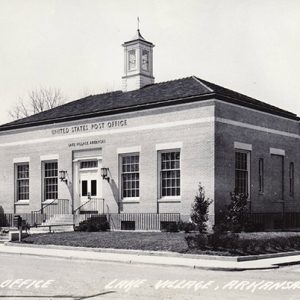calsfoundation@cals.org
Lake Village Post Office
The Lake Village Post Office at 206 South Cokley Street in Lake Village (Chicot County) is a one-story, brick-masonry structure designed in the Colonial Revival style of architecture. It features a mural financed through the U.S. Treasury Department’s Section of Painting and Sculpture (later renamed the Section of Fine Arts), a Depression-era stimulus project that promoted public art. It was listed on the National Register of Historic Places on August 14, 1998.
In August 1937, Congress passed an appropriation bill providing a $23 million lump sum for construction of public buildings. Included in the allocation was $75,000 for a new post office for Lake Village, the seat of Chicot County. Though details of construction could not be located, the building apparently was completed by 1939.
On August 21, 1939, Edward B. Rowan, assistant Section chief, wrote artist Avery Johnson of Denville, New Jersey, and invited him to “submit designs for a mural decoration for the Lake Village, Arkansas, Post Office on the basis of competent work [previously] performed under the Section.” Johnson wrote Rowan on September 27 to accept the invitation but did not submit information needed to prepare the contract for the mural until December 1940. The final contract called on Johnson to create a mural 12′ wide by 5’3″ tall, covering a total area of about sixty-three square feet. Johnson was to receive $750 for the work, which was to be executed in oil on canvas.
Johnson submitted two color sketches as proposals for the Lake Village mural. Rowan informed him on January 17, 1941, that “the one with the cypress trees in the center is preferred. This has the standing deer on the right.” Johnson’s first payment of $150 was approved on February 3, 1941.
In March 1941, Johnson submitted a full-size cartoon of the mural to the Section. “I am also forwarding a print to the local committee down there and will await the approval both of your office and this committee before proceeding with the finished painting,” he wrote in a March 3 letter to Edward Bruce, Section chief. Both apparently were approved, and Johnson was issued a $250 payment on April 1, 1941.
The finished mural was approved for installation on July 23, 1941, and Johnson sent it for installation by a Mr. Purser, who had installed another of the artist’s murals in the Leland, Mississippi, post office. The mural was hung on August, 10, 1941. An August 15, 1941, article in the Chicot Spectator includes a lengthy interview with the artist, noting that Johnson “was especially interested” in the area’s large deer population around Lake Chicot and that “the deer were consequently made the most prominent element in the design.” Lake Village postmaster John F. Mulligan reported the mural safely installed as of September 29, 1941, and Johnson’s final $350 payment was approved on October 29.
Despite a 1967 addition, the Lake Village Post Office—still in use in the twenty-first century—remains a remarkably intact expression of Depression-era Colonial Revival design in a government building. Its historic value is only enhanced by Johnson’s Lake Country Wild Life, a mural that celebrates both the natural bounty of southeastern Arkansas and the Depression-era drive to put all Americans, including artists, to work.
For additional information:
“Arkansas Post Office Murals.” University of Central Arkansas. http://uca.edu/postofficemurals/home/ (accessed October 6, 2020).
“Five Arkansas U. S. Buildings Approved.” Arkansas Gazette, September 10, 1937, p. 26.
“Lake Village Post Office.” National Register of Historic Places nomination form. On file at Arkansas Historic Preservation Program, Little Rock, Arkansas. Online at http://www.arkansaspreservation.com/National-Register-Listings/PDF/CH0062.nr.pdf (accessed October 6, 2020).
Smith, Sandra Taylor, and Mark K. Christ. Arkansas Post Offices and the Treasury Department’s Section Art Program, 1938–1942. Little Rock: Arkansas Historic Preservation Program, 1998. Online at http://www.arkansaspreservation.com/News-and-Events/publications (accessed October 6, 2020).
Mark K. Christ
Arkansas Historic Preservation Program
 Early Twentieth Century, 1901 through 1940
Early Twentieth Century, 1901 through 1940 Historic Preservation
Historic Preservation Lake Village Post Office
Lake Village Post Office  Lake Village Post Office
Lake Village Post Office 




Comments
No comments on this entry yet.